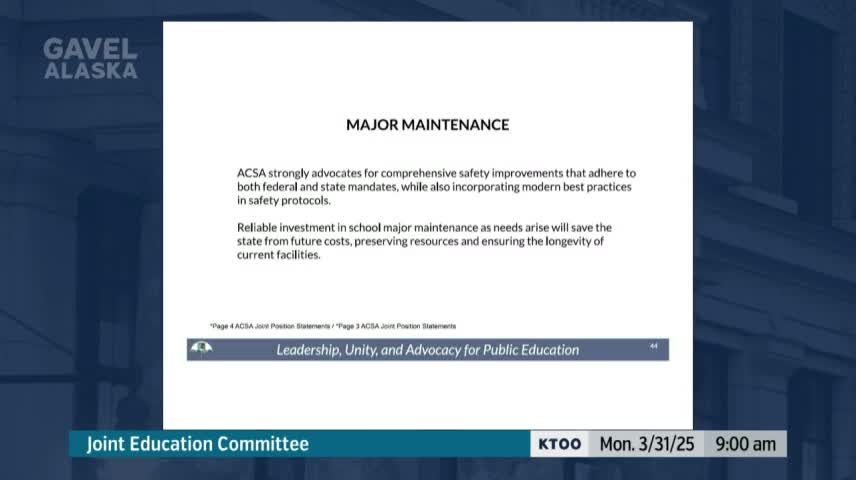District leaders warn of large deferred-maintenance backlog; call to restore bond-debt reimbursement
March 31, 2025 | 2025 Legislature Alaska, Alaska
This article was created by AI summarizing key points discussed. AI makes mistakes, so for full details and context, please refer to the video of the full meeting. Please report any errors so we can fix them. Report an error »

Juneau, Alaska — School business officers and superintendents told the joint education committee March 31 that deferred maintenance on school buildings has grown to hundreds of millions of dollars and that changes to bond-debt reimbursement have worsened local backlogs.
“We are road system and village, off the road system district. At one site that is so old and the pipes are corroded, we're on a regular basis… have to have a vacuum cleaner to clean up sewage coming out of those pipes,” Clayton Holland, superintendent of the Kenai Peninsula Borough School District, told the committee, describing unsafe, aging infrastructure in some communities.
Holland said his district faces roughly $400,000,000 in deferred maintenance. Katie Parrott of Anchorage School District and Philip Hewlett of the Alaska Association of School Business Officials told lawmakers that reductions and moratoria in school bond debt reimbursement have prompted districts to delay projects, which raises long-term costs and forces short-term, often more expensive repairs.
“Due to the moratorium on school bond debt reimbursement, many districts have deferred school construction projects and that has led to a deterioration of facilities and long term damage leading to unsafe conditions,” Parrott said, citing the Anchorage district’s maintenance backlog and charting how state reimbursement changes have shifted costs into operating budgets.
Why it matters: Presenters said deferred maintenance and reductions in bond-debt reimbursement reduce instructional capacity, harm building safety and increase operating costs that otherwise would be available for classroom services.
Ending: Business officials urged the Legislature to consider targeted capital funding, bond-debt reimbursement policies and strategic statewide assessments to prioritize projects and avoid escalating costs.
“We are road system and village, off the road system district. At one site that is so old and the pipes are corroded, we're on a regular basis… have to have a vacuum cleaner to clean up sewage coming out of those pipes,” Clayton Holland, superintendent of the Kenai Peninsula Borough School District, told the committee, describing unsafe, aging infrastructure in some communities.
Holland said his district faces roughly $400,000,000 in deferred maintenance. Katie Parrott of Anchorage School District and Philip Hewlett of the Alaska Association of School Business Officials told lawmakers that reductions and moratoria in school bond debt reimbursement have prompted districts to delay projects, which raises long-term costs and forces short-term, often more expensive repairs.
“Due to the moratorium on school bond debt reimbursement, many districts have deferred school construction projects and that has led to a deterioration of facilities and long term damage leading to unsafe conditions,” Parrott said, citing the Anchorage district’s maintenance backlog and charting how state reimbursement changes have shifted costs into operating budgets.
Why it matters: Presenters said deferred maintenance and reductions in bond-debt reimbursement reduce instructional capacity, harm building safety and increase operating costs that otherwise would be available for classroom services.
Ending: Business officials urged the Legislature to consider targeted capital funding, bond-debt reimbursement policies and strategic statewide assessments to prioritize projects and avoid escalating costs.
View full meeting
This article is based on a recent meeting—watch the full video and explore the complete transcript for deeper insights into the discussion.
View full meeting
